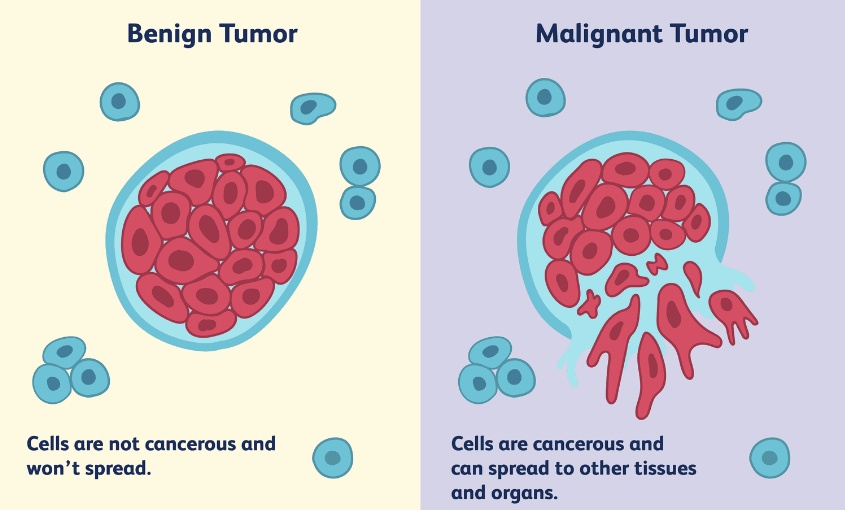Cancer is a term that strikes fear into the hearts of many. It's a complex and multifaceted disease that affects millions of people worldwide. When we talk about cancer, the term "tumor" often comes up in discussions. But what exactly are tumors, and how do they relate to cancer? In this blog, we'll explore the key differences and similarities between tumors and cancer to help you better understand this challenging disease.
Tumors: The Basics
A tumor is an abnormal mass or lump of tissue that can develop anywhere in the body. Tumors can be benign or malignant, and this is where the fundamental difference between tumors and cancer lies:
Benign Tumors:
Benign tumors are non-cancerous growths. They do not invade nearby tissues or spread to other parts of the body. While benign tumors can still cause health problems depending on their location and size, they are generally not life-threatening. Examples of benign tumors include uterine fibroids, lipomas (fatty tumors), and moles.
Malignant Tumors (Cancer):
Malignant tumors, on the other hand, are cancerous growths. They are characterized by their ability to invade surrounding tissues and spread to other parts of the body, a process known as metastasis. Cancer cells are invasive and can disrupt the normal functioning of organs and systems. The key to understanding cancer is recognizing that it's not just the presence of a tumor, but the behavior of the cells within that tumor that makes it malignant.
Similarities between Tumors and Cancer
While benign tumors and cancerous tumors are fundamentally different, they share some commonalities:
-
Cell Origin: Both benign and malignant tumors originate from the body's own cells. The primary difference lies in how these cells behave and interact with their surroundings.
-
Growth: Both types of tumors exhibit uncontrolled growth. They grow larger over time, often forming a mass of tissue.
-
Diagnosis: Diagnosing whether a tumor is benign or malignant typically involves medical tests, such as imaging (e.g., X-rays, CT scans, MRI), biopsies, and laboratory analysis.
-
Symptoms: Benign and malignant tumors can cause symptoms, depending on their location and size. These symptoms might include pain, changes in organ function, or the development of physical lumps or masses.
-
Treatment: Depending on their location and characteristics, both benign and malignant tumors may require medical intervention. Treatment options can include surgery, radiation therapy, chemotherapy, or other targeted therapies.
Key Differences between Tumors and Cancer
-
Invasiveness: As mentioned earlier, the primary difference between benign and malignant tumors is their invasiveness. Benign tumors do not invade nearby tissues or spread to other parts of the body, while cancerous tumors do.
-
Metastasis: Malignant tumors have the ability to metastasize, meaning cancer cells can break away from the primary tumor, travel through the bloodstream or lymphatic system, and form secondary tumors in distant organs or tissues. This is a hallmark of cancer.
-
Cell Behavior: The behavior of the cells within a tumor is what ultimately defines it as cancer. In cancer, the cells lose their ability to regulate their growth and division, leading to the formation of an aggressive and destructive mass of tissue.
-
Prognosis: The prognosis for benign tumors is generally good, as they are typically non-life-threatening. In contrast, cancerous tumors carry a more serious prognosis, depending on factors like the cancer's stage, type, and location.
-
Treatment Approach: The treatment approach for benign and malignant tumors differs significantly. Benign tumors are often treated by surgical removal, while cancer treatment can include surgery, radiation therapy, chemotherapy, immunotherapy, or targeted therapy, among other options.
Conclusion
In summary, tumors are abnormal masses of tissue that can be benign or malignant. Benign tumors are generally non-cancerous and do not invade surrounding tissues or spread to other parts of the body. Malignant tumors, on the other hand, are cancerous, characterized by their invasive nature and the ability to metastasize.
Understanding the differences and similarities between tumors and cancer is essential for both patients and healthcare professionals. It helps guide diagnosis, and treatment decisions and provides insight into the potential prognosis of the disease. If you or a loved one is facing a tumor or cancer diagnosis, consult with a medical professional to develop a comprehensive care plan tailored to your specific situation.


No comments yet